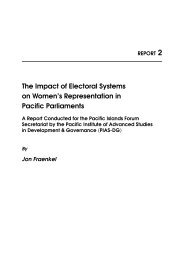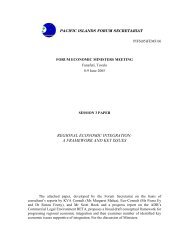PUBLIC PRIVATE PARTNERSHIPS AND BUILD, OPERATE AND TRANSFER (BOT ...
PUBLIC PRIVATE PARTNERSHIPS AND BUILD, OPERATE AND TRANSFER (BOT ...
PUBLIC PRIVATE PARTNERSHIPS AND BUILD, OPERATE AND TRANSFER (BOT ...
You also want an ePaper? Increase the reach of your titles
YUMPU automatically turns print PDFs into web optimized ePapers that Google loves.
� Fiji has an open and competitive economy. Various reforms are being pursued in<br />
civil service, financial management, and public enterprises. This will all contribute to<br />
competitiveness for Fiji economy, thus adding stimulus to PPP;<br />
� there is a medium to long-term pipeline of projects, which could be subjected to PPP;<br />
and<br />
� an institutional regulatory and legal framework to promote PPP projects is being<br />
developed.<br />
Current Government Policy<br />
28. A key priority of the Fiji Government is to raise the annual level of investment to<br />
at least twenty-five percent of gross domestic product. It intends to achieve this goal by<br />
increasing public investment – particularly in physical infrastructure and human capital –<br />
and by stimulating and facilitating higher levels of private investment.<br />
29. Furthermore, one of the Strategic Priorities of Fiji’s Strategic Development Plan<br />
(SDP 2003-2005) is “Structural reforms to promote competition and efficiency”. Public<br />
Private Partnerships or PPPs are an appropriate solution to this priority as well as the<br />
Governments continual search for better value for money and better ways of delivering<br />
public infrastructure and related services.<br />
Scope of Public Private Partnerships<br />
30. A PPP is an arrangement between the public and private sectors (consistent with a<br />
broad range of possible partnership structures) with clear agreement on shared objectives<br />
for the delivery of public infrastructure and/or public services by the private sector that<br />
would otherwise have been provided through traditional public sector procurement.<br />
31. A particular arrangement or project may constitute a PPP where the following key<br />
objectives have been met:<br />
(i) Better value for money and optimal allocation of risk, for example, by<br />
exploiting private sector competencies (managerial, technical, financial<br />
and innovation) over the project’s lifetime and by promoting the crosstransfer<br />
of skills between the public and private partners;<br />
(ii) Shared responsibility for the provision of the infrastructure or services<br />
with a significant level of risk being taken by the private sector, for<br />
example, in infrastructure projects linking design and construction with<br />
one or all of the finance, operate and maintain elements; and<br />
(iii) Encourage and promote resource owners participation in infrastructure<br />
development.<br />
32. There is a clear distinction between a PPP arrangement under which the private<br />
sector partner supplies public infrastructure and public services on behalf of the state for<br />
the contract period and the sale (i.e. privatisation) to the market sector of specific state<br />
assets. This policy reflects the former arrangement and is not regarded as being<br />
privatisation.<br />
9
















